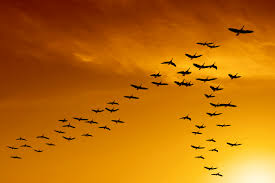
This morning, as I was watering the flower bed in front, I heard honking. Not from the street. From above.
I looked up, spotting a solitary goose winging southeast. Right direction. But why was he (irresponsibly assuming "it" was a "he") alone? Had he gotten separated from his flock? Was the poor fellow lost -- desperate, dejected, disoriented?
There were no other geese in sight. Just our buddy in the empty, cloud-strewn sky. Call without response. Driven. Undaunted. Following his internal compass. Emblem of the eternal migration.
Great, but what was wrong with this bird?
- It's said that "Geese honk from behind to encourage those up front to keep up their speed." But there were no other birds ahead of this one. So who was he urging on?
- It's common knowledge: geese fly in flocks (a wise thing to do when you're taking multi-thousand-mile trips). Why wasn't our friend comfortably aloft in a familiar, time-tested, bomber-squadron, V-shaped formation? Was he simply a slow-poke, lagging behind? Was he delirious? Damaged? In dire straits?
- Migration is a learned process. Perhaps our pal was an unschooled fledgling.
- Remember: geese mate for life. Where the blazes was this guy's partner? And should we assume the worst about him because he didn't have one?
The National Academy of Sciences estimated in 2006 that wind energy is responsible for less than three out of every 100,000 bird deaths caused by human activities. House cats kill an estimated 1 billion birds annually in the U.S. alone; buildings 100 million to 1 billion; automobiles 60-80 million; power lines hundreds of thousands to as many as 175 million, according to the U.S. Fish & Wildlife Service and other sources.Many migrating birds never reach their destinations because
When they are flying near buildings [in metropolitan areas], the nighttime lights can confuse the birds. Sometimes they crash into the lit building; other times, decorative lights disorient the birds and cause them to circle around and around, finally settling exhausted in a street tree or bush at daybreak. From there, “birds can fly into glass windows as they fly toward a reflection or even a planter inside the building,” explains Rebekah Creshkoff of the New York City Audubon Society.Chicago, to its credit, "was one of the first U.S. cities to address nighttime bird deaths. The [Lights Out] program encourages building managers to dim or turn off decorative lighting late at night and to minimize the use of bright interior lights during migration season." (Great news for our friend if he was passing through downtown Chicago at night.)
Search the Web and you'll find plenty of facts ("Swans and geese are the largest waterfowl") and lore (Mother Goose, golden eggs).
- Federal Goose Control Inc. argues that "In recent years Canada geese have become an urban nuisance" that should be combated with trained Border Collies, remote-controlled watercraft, and nontoxic chemical deterrents.
- BirdWatching-Bliss.com refutes the myth of "goose-riding": "[Migrating] Hummingbirds do not ride on the backs of geese." So we do know that the goose I saw wasn't, in taxi fashion, giving a hummingbird a lift.
There's a book titled Solitary Goose. Maybe that has some insights.
Wikipedia assures us that "Most Canada geese have staging or resting areas where they join up with others." Perhaps, at the next rest stop -- some bucolic, secluded pond -- the flock is staging a pull-out-all-the-stops reunion shindig.
National Geographic says that geese "can cover 1,500 miles in just 24 hours with a favorable wind." Let's hope that, no matter his insecurities, limitations, and struggles, our friend, boosted by unflagging stamina and a stiff wind, will shortly and joyfully reunite with his befeathered brethren.


Well crafted and interesting; however, other than the beginning (you, hose in hand), I don't get how this is the concern of the reconstructed man.
ReplyDelete